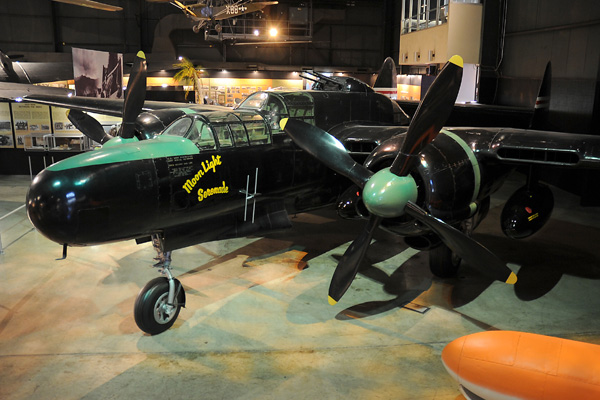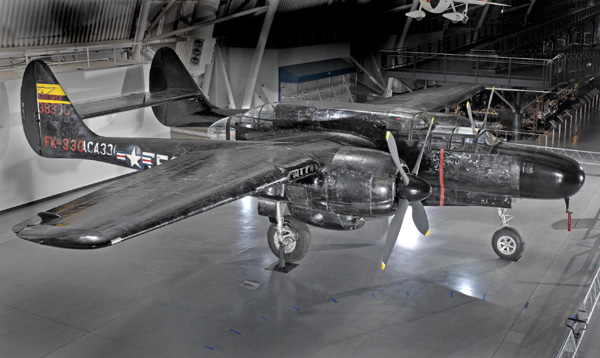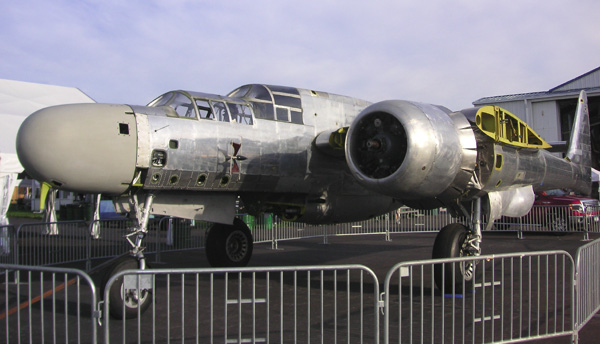
|
Northrop P-61 Black Widow |
 |
||||||||
|---|---|---|---|---|---|---|---|---|---|---|
 |
 |
 |
 |
 |
 |
 |
 |
 |
 |
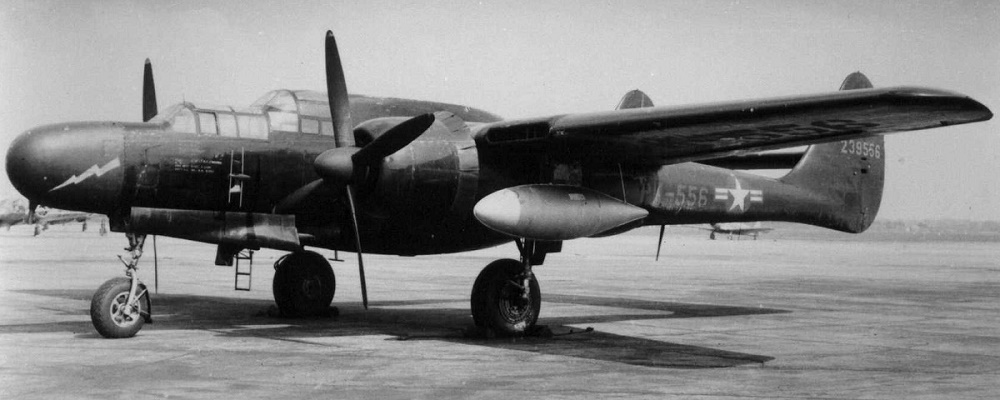
|
|
The Northrop P-61 Black Widow gets a lot of attention considering the relatively small role it played in World War II. Unlike the P-47 Thunderbolt and P-51 Mustang, it did not have an impressive number of kills. It downed only about 127 aircraft (18 were V-1 Buzz Bombs). Its overall impact on the war was minimal and its victories were sporadic. In comparison, the Junkers Ju-88 had more night victories than all Allied fighters combined.1 Only 674 P-61s were built during the war (32 more after the war's end) and it served in the war just over a year. The bottom line, a lot of resources went into an aircraft with very little to show for it.
It was a sleek looking aircraft, but there was a mystique to it. One could imagine this mysterious nocturnal blackguard, lurking in the depths of night and claiming victims without even knowing what hit them. She was a venomous dark lady. Hence the name, Black Widow. While one may be critical of its overall contribution to the war effort, it was no fault of the airplane, the manufacturer or aircrews. The development time was about the same as most other WW II aircraft, but it was just too late in the game to be of any great consequence. It didn’t go into combat until after D-Day and by the end of the war, the Allies had established air superiority on all fronts. Enemy aircraft were few and far between—particularly at night, which accounts partially for the low tally of victories, but it’s not the whole story. Protected by two oceans, initially the U.S. had no need for a night-fighter, so it began as a request by the British, which had been suffering from the London Blitz. Having the most experience with night-fighting, the British had the greatest input. British specifications were based on experience and not speculation. On both sides of the war, air losses were too great to sustain through daylight raids and attacks were switched to night bombing. The British found that before they could pursue the attackers, their bombs had already been dropped, so speed was not a primary concern. A night-fighter would be required to loiter for at least seven hours without causing pilot fatigue and still have enough reserve to meet the enemy in a high-speed engagement.2 |
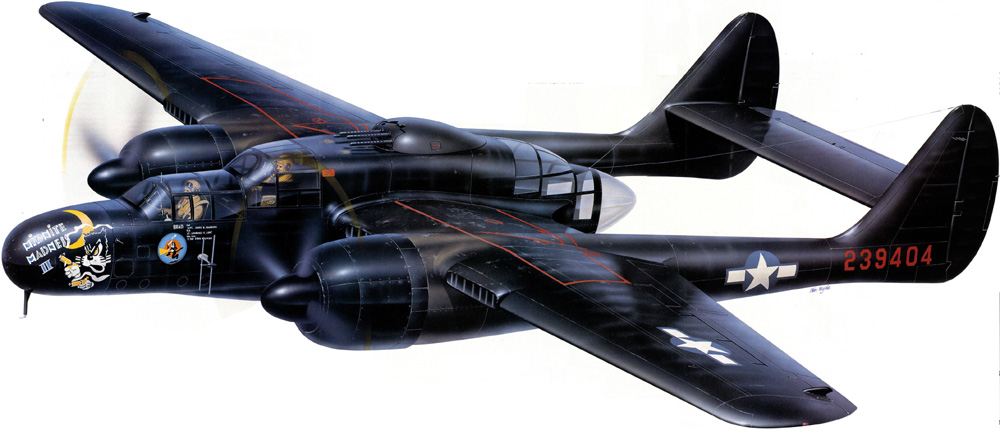
|
|
The British first used visual tactics for night interceptions, but then began adapting aircraft with Airborne Intercept (AI) radar to fend off the night raiders. The latest radar would be needed and heavy firepower was required. But to its detriment, the lack of speed and high-altitude capabilities would be the Black Widow’s undoing. Unfortunately, Northrop engineers decided not to add turbo-superchargers to the earlier P-61s, because they were worried that this would increase fuel consumption and adversely affect loiter times. By the time it had entered service, much progress had been made since the creation of the 1940 specifications and now the Black Widow was hard pressed to compete.
In the end, after testing a P-61A with less than favorable results, the British never ordered the Black Widow. Instead they preferred the night version of their own de Havilland Mosquito which had already proven to be an extremely good night-fighter. |
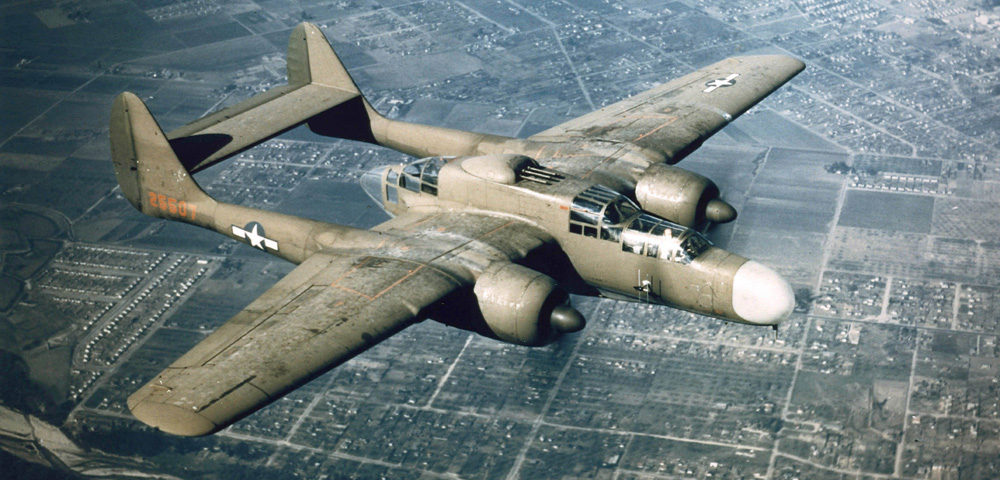
|
|
It was a Big Airplane
The P-61 was an all-metal twin boom design and had a crew of three: pilot, gunner and radar operator. It was a large aircraft which was unusual for a fighter. It had devastating firepower and was armed with four 20 mm Hispano forward-firing cannons in the belly, which could be serviced from the ground without platforms, and four 0.50 caliber machine guns, mounted in an upper rotating dorsal turret. The guns were mounted aft of the cockpit, which was a beneficial feature that protected the pilot’s night vision from the gun muzzle flash. It was powered by two Pratt & Whitney R-2800 engines in nacelles which tapered into twin tail booms connected by a central horizontal stabilizer. Twin booms were selected to provide a stable gun platform. It had a tricycle landing gear, featured full-span retractable flaps and had an internal fuel capacity of 646 gal (2,445 l). Provisions were made for external racks to carry up to four 1,600 lb. (725 kg) bombs or drop tanks. The Northrop design was formalized as Specification 8A (or NS-8A) on December 5, 1940 and was selected over the Douglas XA-26A. On January 11, 1941, a contract was signed for two XP-61 prototypes and two wind-tunnel models. On March 10, 1941, a contract was issued for 13 YP-61 service test aircraft, plus one engineless static test airframe.3 Originally the 20 mm cannons were to be mounted in the wings, but after an inspection of the mockup in April 1941, the cannons were moved to the belly, which made them easier to service. Fuel capacity was increased from 540 gallons (2,044 liters) in two tanks to 646 gallons (2,445 liters) in four self-sealing tanks built into the wings. A letter of intent was initiated on December 24, 1941, which called for 100 P-61 production aircraft and spares. Fifty more were ordered on January 17, 1942. The order was increased to 410 aircraft on February 12, 1942, fifty of which were to be diverted to the RAF under Lend-Lease, which was eventually cancelled. The inaugural flight was on May 26, 1942. The P-61 could have been mistaken for a medium bomber, because of its size and weight, but despite the Black Widow’s tepid performance, American pilots loved their P-61s. They praised its handling qualities as it could perform all sorts of aerobatics and it had a gentle stall behavior. Full control could be maintained on one engine—even when fully loaded. It could be slow-rolled into a dead engine, a maneuver that was devastating on the Lockheed P-38 Lightning.4 Its turning radius was excellent, and it gave some single-engine fighters a good run for their money. |
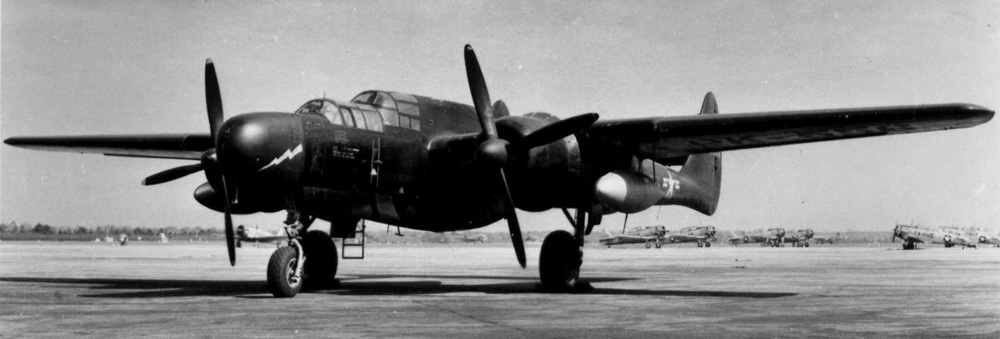
|
|
The P-61 featured innovations that would be introduced on later aircraft such as spoilers for lateral control. The spoilers alone would have been sufficient to provide all the lateral control required, but small ailerons were installed at the wing tips to provide aileron feel. It also had an automatic pilot and remote fire-control. All firepower would be contained in the crew nacelle and the radar would be contained in the nose, unlike other AI radar equipped aircraft that had an array of antennas which could reduce speed by 25 mph (40 km/h). It was one of the best handling aircraft of the war, but its performance in speed and altitude was lacking. It was too low and too slow to be an effective night-fighter, until an upgraded P-61C version was developed with increased performance. However, by that time it was too late—the war was over.
P-61A The P-61A was the first production model and rolled off the production line in October 1943. Unlike the XP-61 and YP-61, which were painted flat black, the early P-61As were olive drab. Only the first thirty-seven production models were equipped with a dorsal turret. The General Electric remotely-controlled turret mechanism was in short supply and needed for the Boeing B-29s. However, for the most part, the upper guns caused buffeting on the tail when the turret was rotated. The problem became so severe that the upper guns were locked in the forward position and firing was controlled by the pilot. In some cases the top turret was removed in the field and replaced with an additional fuel tank that was faired over. With the upper turret removed, many missions were completed with only two crew members, but sometimes the gunner went along, if only to provide an additional set of eyes. Later models were powered with War Emergency Power (WEP) R-2800-65 water-injected engines. WEP was activated during emergency situations by pushing the throttle to "full stop," which was normally limited by a break-away wire. Twenty were modified prior to delivery with the addition of pylons on the outer wing panels to carry either a pair of 265-gallon (1,003 liter) fuel tanks (later 310-gallon (1,173 liter) tanks were fitted) or a pair of 1,600-pound bombs. One major problem that surfaced was the failure of the Plexiglas tail dome which used to break off during high-speed dives. The tail cone was strengthened by replacing the welded magnesium alloy booms of the prototypes with more conventional aluminum alloy booms. This solved some problems with tail cone failures but not entirely. Afterwards, P-61s were painted gloss black which became the Black Widow's trademark. Three paint schemes were tested which were olive drab with a flat black underside, all flat black and gloss black. During searchlight tests, when the olive drab and flat black painted aircraft passed the searchlight beams, they were easily detected. However, when the gloss black aircraft flew across the beam it was nearly invisible. Air Intercept (AI) Radar Great Britain had been experimenting with radar since 1936, and in the beginning, it was too large to fit onboard aircraft—it could only be used for installations on land or ships. The early night-fighters were ineffective, because they lacked airborne radar, but with the British invention of the cavity magnetron, microwave radar was developed and it now was able to fit within an aircraft. An offshoot of the British research was the SCR-520 AI radar. SCR stood for "Searchlight Controller Radar". It was developed by Bell Telephone Laboratories in conjunction with the Radiation Laboratory at MIT in Massachusetts. In 1943, Western Electric was selected as the manufacturer for mass production and produced the SCR-720. It was the primary night-fighter radar used by the Allies in World War II and was similar to the AI Mark X used on the British night-fighters.5 The radar operator located targets on his scope and vectored the pilot to the target. Once within range, the pilot used a smaller scope on the main instrument panel to close in on the target, which had a range of nearly five miles (8 km). |

|
|
P-61B
The P-61B was essentially the same as the P-61A, but with a number of improvements. It introduced the more advanced SCR-720 AI radar. The nacelle was eight inches longer and the nose radome was longer to accommodate the new radar. The landing gear doors were changed to split mechanical doors rather than the problematic hydraulically actuated doors. The doors were also elongated to prevent debris from being thrown up into the wheel wells during takeoff and landing. An emergency landing gear extend system was installed, in case of a hydraulic failure, and a landing gear handle mechanical latch was installed to prevent landing gear retraction on the ground. An improved cabin heating system was installed, as well as cowl flaps, an oil cooler and inter-cooler doors. The oil tanks were relocated from the wings to the engine nacelles. A landing light was installed on the landing gear, the aileron trim tabs were deleted and an engine fire extinguisher system was installed. For the inexperienced, the only way to tell the difference between the A and B model exterior was by an access panel aft of the radome on the P-61B. Night-vision binoculars were introduced on the B-model in order to see the target and were later retrofitted to many P-61As already in the field. An APS-13 tail-warning system was added and some P-61As and many early P-61Bs were retrofitted in the field. Four underwing pylons were installed for either 258-gallon (977 liter) drop tanks or four 1,600-pound bombs. The General Electric Type A-4 dorsal turret was reinstalled on the 201st P-61B after the buffeting problems had been corrected.6 |
 The P-61C has a large air scoop under each engine. |
|
P-61C The P-61C was essentially the same airframe, but with more powerful turbosupercharged R-2800-73 radials offering a max WEP of 2,800 hp (2,088 kW). It was heavier than the A or B models and was said to be less maneuverable. Exterior differences of the XP-61C were a large air scoop under each engine and paddle-bladed A.O. Smith propellers to take advantage of the increased power. The first production P-61C rolled off the line in early 1945 and was much faster with a maximum speed of 430 mph (692 km/h) at 30,000 ft (9,144 m). Perforated airbrakes were located above and below the wing, but these were locked shut after a serious accident during a high-speed test. It was equipped with four underwing pylons that could carry four 310-gallon (1,174 liter) drop tanks. The first P-61C was accepted by the USAAF in July 1945, but it was too late to see combat. Forty-one P-61s were completed by January 28, 1946. The service life of the P-61C was quite short and was quickly outclassed by jet aircraft. Most were used for test and research purposes and by the end of March 1949, most P-61Cs were scrapped. The Northrop P-61 Black Widow in Action When the Black Widow did work, the results were spectacular. It was the first purposely built night-fighter aircraft, unlike the Douglas Havoc, Grumman F6F Hellcat, Bristol Beaufighter and de Havilland Mosquito which were adapted for the role. The 422nd Night Fighter Squadron (NSF) was the first to fly the P-61 in Europe and the “Green Bats” received their P-61s on May 23, 1944. The 425th received their Widows on June 15, 1944. Both squadrons received their Widows too late to take part in the D-Day invasion on June 6th, and the earliest missions for both squadrons were against the dreaded V-1 “Buzz Bombs.” In the Mediterranean, the 414th received its P-61s on December 20th and they worked together with the 422nd during the Battle of the Bulge. Between February 4, 1945 and April 10, 1945, they shot down five German Aircraft. At the end of 1944, the 422nd and 425th were critically short of spare parts and each squadron was down to ten or fewer serviceable aircraft. Northrop could not keep up with the demand and the problem was never corrected. The squadrons made do with whatever equipment was available to them. Germany produced some of the fastest aircraft of the war and during one encounter with a Messerschmitt 410, during the Battle of the Bulge, the shortcomings of the P-61 became apparent. Lt. Van Neiswender was piloting his P-61, the “Daisy Mae.” and he was directed towards a bogey by Ground Control Intercept (GCI). As soon as he locked onto the target, the Me 410 did a half-roll and dove straight for the woods below. The P-61 pursued its target at full throttle and by the time the target was identified as an Me 410, it began pulling away quickly at 400 mph (644 km/h) as if the P-61 was standing still. Neiswender lost radar contact and never got close enough to fire his guns. Seconds later, the tail cone of the P-61 collapsed and separated from the airplane. P-61s experienced repeated tail cone failures during dives. After three hours of mission time, Neiswender headed back to base with nothing to show for his efforts. In the Pacific Most of the P-61As went to the USAAF Night Fighter Squadrons in the Pacific. After Guadalcanal was secured in late 1942, it was realized that the American stronghold was in striking distance of many Japanese bases in the surrounding area. Very quickly it became apparent that American bases would be in need of nighttime protection. The P-61 was still a ways off and the American night-fighter program began with utilizing B-25s, P-40s, P-38s and P-70s adapted as night-fighters. It wasn’t until May 1944 when the P-61 was finally delivered to Pacific squadrons. The 6th NFS was the first to receive the new P-61A fighters. They were finished in olive drab and were also equipped with the top turret, which was later deleted due to tail buffeting problems. The 6th NFS was the only night-fighter squadron in operation at the beginning of the war, and it wasn’t until April 1, 1943, that the 418th and 419th NFSs were activated, using B-25s, P-38s and P-70s. When the P-61 finally showed up in 1944, the high-flying G4M Betty bomber would no longer be out of reach and the 6th NFS was the first to take one down with a night-fighter. On June 30th, a lone Betty was sent out to bomb the airfield on Saipan at an altitude that was out of operational reach of the P-70. Lieutenant Dale Haberman and Flight Officer were on patrol duty that night and picked up the Betty on radar. Haberman set up his P-61 for the best firing angle and put a short 20 mm burst into the Betty. The result was devastating and the Betty quickly exploded. This would be the first of 16 kills for the 6th NFS flying the P-61. On July 1, 1944, the 421st NFS was activated and operated from bases at Nadzab, New Guinea, Wake Island and several forward bases. On July 7th, Flight Lieutenant Own Wolf and Radio Officer (RO) Lieutenant Byron Allain were on alert at a forward base on Owi Island, and were directed by GCI to intercept an incoming bogey. Due to a rain squall in the area, GCI lost contact and Wolf continued heading in a westerly direction until he finally picked up the bogey at the maximum range of his radar. Wolf came into range of the unsuspecting bomber, which was identified as either a Mitsubishi Ki-21 “Sally” or Mitsubishi Ki-46 “Dinah” twin-engine bomber. Once in position, Allain fired the four 0.50 caliber machine guns and Wolf fired the four 20 mm cannons, both at the same time. The starboard engine burst into flames and Wolf continued to press the attack. Parts of the fuselage exploded and the bomber burst into a ball of flame and went down into the ocean. The 418th NFS was based at Morotai, Halmaheras, Netherlands East Indies and was the top scorer in the P-61 with 18 kills. The 418th was able to bag three Kawasaki Ki-61 Hein “Tonys” in one night. The Tony was a new fighter that had been wreaking havoc on the B-29 Superfortresses. The 421st was able to down two Tonys on November 10, 1944. After the War and Other Developments The P-61 was retired as a night-fighter as soon as the war ended having been replaced with the F-82 Twin Mustang and Northrop F-89 Scorpion jet fighter. Service continued after the war with a limited role as the F-15 Reporter and with the USMC designated as F2T-1N radar trainers. The P-61 served solely with the U.S. forces and never served with any foreign air force. XP-61D The XP-61D was basically the same as the P-61C and was powered by R-2800-77 turbosupercharged engines with WEP of 2800 hp (2,088 kW). It had four wing pylons, two inboard and two outboard of the engine booms. The flight test program for the two XP-61Ds was completed by the fall of 1945. Maximum speed was 430 mph (692 km/h) at 30,000 ft (9,144 m), and an altitude of 30,000 ft could be attained in 13.5 minutes. Service ceiling was 43,000 ft (13,106 m). After the P-61C entered production, the priority for the XP-61D was lowered and when the war ended in the Pacific, the XP-61D project was dropped altogether. Both airplanes were scrapped. XP-61E The XP-61E was to be a bomber escort version of the Black Widow, but when the P-51D Mustang proved to be more than adequate for the same role, the XP-61E was no longer a priority. Two P-61Bs were converted as E models, but not completed until March of 1945. It had an advantage over previous Black Widow night-fighters, but it wasn't anywhere near as fast as the North American XP-82 Twin Mustang. The XP-61E had a maximum speed of 376 mph (605 km/h) at 17,000 ft (5,182 m), whereas the XP-82 was 106 mph (170 km) faster with a maximum speed of 482 mph (776 km/h) at 25,100 ft (7,650 m). The XP-61E central fuselage nacelle was completely revised with a tandem two-seat cockpit and bubble canopy with the third seat in the rear being eliminated. The radar was also removed and replaced with four 0.50 caliber machine guns in the nose. Additional fuel tanks were installed increasing internal fuel to 1,158 gallons (4,385 liters). One XP-61E crashed in April 1945 after the test pilot retracted the landing gear prematurely during a high-performance takeoff. The pilot was unhurt, but the aircraft was a total loss and the project was cancelled. P-61G During 1945, 16 P-61Bs were converted to P-61Gs for weather reconnaissance. All armament was deleted. F-15 Reporter The surviving XP-61E was modified as a photographic reconnaissance aircraft and designated as an XF-15 Reporter. All guns were removed and a new nose was installed to house a series of aerial cameras. Its inaugural flight was on July 3, 1945. A P-61C was also modified as an XF-15 and was identical to the converted XP-61E, except for the turbosupercharged R-2800 engine. It had a new bubble-canopy fuselage and the wing air brakes were eliminated. In June of 1945, 175 production F-15As were ordered, but the F-15A was cancelled in 1947, because jet aircraft were coming into service. Only 36 F-15As were completed. F-15 Reporters served after the war during the American occupation of Japan, and participated in mapping program and provided invaluable pictures of Korea before the war. Some F-15s also served in the Philippines. Getting spare parts for the F-15 became a problem in the late 1940s and both damaged and serviceable aircraft were cannibalized to keep the few available aircraft flying. In August 1948, the "F" designation for reconnaissance aircraft was eliminated and was used for fighter aircraft. Black Widows still in service were redesignated as the F-61, and Reporters were redesignated RF-61C, being that the Reporter was essentially a modified P-61C. On April 1, 1949, the last outfit using RF-61Cs (the 82nd Tactical Reconnaissance Squadron) was deactivated, and all surviving RF-61Cs were reassigned to the 35th Maintenance Squadron at Johnson AFB for disposal. Some were declared surplus and sold on the commercial market, and the remainder were scrapped. F2T-1 The US Navy operated P-61 Black Widows, designated as F2T-1 trainers, while waiting for their first delivery of Grumman F7F Tigercats. They were to operate from land bases to replace Lockheed PV-1 Venturas, Vought F4U Corsairs, and Grumman F6F Hellcats throughout the Pacific. The USAAF had priority on deliveries of P-61 Black Widows and the Navy did not receive Black Widows until mid-1944. The Naval F2T-1s were to be issued to Marine Corps night-fighter units. In July 1944, the Navy decided to operate Grumman F7F Tigercat as its primary night fighter and cancelled its request for Black Widows. A dozen ex-USAAF P-61Bs were acquired as crew trainers until the Tigercats arrived. However, the F2T-1s did not enter service with the Navy until September of 1945, by which time the war in the Pacific was over. The Naval F2T-1s served with shore-based training units for only a brief time, and the survivors were eventually transferred to support units. The last two F2T-1s were removed off Navy rolls in August of 1947. |
|
There are only four know surviving P-61s of which all are located in Air Museums:
|
| Specifications: | |
|---|---|
| Northrop P-61A Black Widow | |
| Dimensions: | |
| Wing span: | 66 ft 0 in (20.12 m) |
| Length: | 48 ft 11 in (14.91 m) |
| Height: | 14 ft 2 in (4.32 m) |
| Weights: | |
| Empty: | 20,965 lb (9,510 kg) |
| Max T/O: | 32,400 lb (14,696 kg) |
| Performance: | |
| Maximum Speed: | 369 mph (594 km/h) |
| Cruise Speed: | 294 mph (500 km/h) |
| Service Ceiling: | 33,100 ft (10,090 m) |
| Range: | 1,000 miles (1,609 km) with internal fuel. |
| Max Range: | 1,900 miles (3,058 km) with external fuel. |
| Powerplant: | |
| Two 2,250 hp (1,678 kW) Pratt & Whitney R-2800-65 radial engines. | |
| Armament: | |
|
Four belly 20-mm cannons and four 0.50 caliber dorsal turret machine guns. | |
Endnotes:
|
Return to Aircraft Index
©Larry Dwyer. The Aviation History Online Museum.
All rights reserved.
Created November 7, 2014. Updated August 24, 2024.
